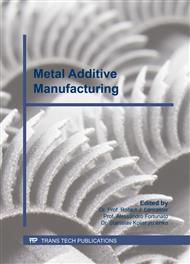p.1238
p.1242
p.1248
p.1254
p.1260
p.1264
p.1270
p.1276
p.1282
Fabrication of the Beta-Titanium Alloy Rods from a Mixture of Pure Metallic Element Powders via Selected Laser Melting
Abstract:
The powder-bed additive manufacturing (AM) process offers advantages in terms of reduced material waste, ability to create complex shape and a decrease in the lead time from design to manufacturing. Recently, custom-made implant of Ti alloys is being developed by selective laser melting (SLM) in additive manufacturing (AM) process. However, the difficulty in the fabrication of titanium alloys due to their pre-alloyed powder cost, resulting in a limited usage of titanium alloys. To overcome this disadvantage, it is effective to fabricate the Ti alloys by SLM from mixture of pure elemental powders. In this case, it is avoided the preparing of the pre-alloyed powders. Therefore, the purpose of the present study is the trying to the fabrication of the Ti-20at.%X (X = Cr, Nb) alloys from the mixture of pure elemental powders by SLM.
Info:
Periodical:
Pages:
1260-1263
Citation:
Online since:
December 2018
Keywords:
Price:
Сopyright:
© 2018 Trans Tech Publications Ltd. All Rights Reserved
Share:
Citation:



